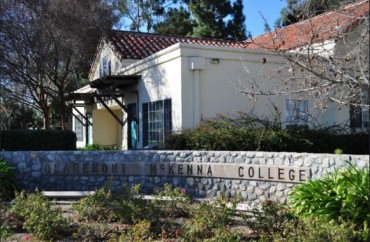
But the damage has already been done
Not all students remain silent as their university is maligned by a small but vocal group of raucous protestors.
Hundreds of students at Claremont McKenna College have pushed back against protests on their campus that accuse the private, liberal arts school of systemic racism and oppression. The protests followed similar unrest at the University of Missouri and Yale, which both drew national attention earlier this month.
Although the dean of students has already lost her job over the unrest and the president of the school has promised to support new diversity efforts in the protests’ wake, many students at the school who disagreed with demonstrators did not take the accusations lightly.
A recent letter to the campus community signed by more than 300 students states “we do not condone many of the actions of the movement.” It comes on the heels of a “We Dissent” editorial from a campus newspaper at the school run by conservatives and libertarians.
The letter criticizes grievances lodged by student protestors, picking apart each one of their complaints and chastising them for intimidating and silencing peers who disagree.
“Never did we think the day would come where we were scared to speak our minds, where fear of our fellow students’ rage silenced us,” the letter states.
The Nov. 15 letter came three days after an editorial in the Claremont Independant denounced the protests, which also criticized demonstrators’ complaints and ended with: “We are not racist for having different opinions. We are not immoral because we don’t buy the flawed rhetoric of a spiteful movement. We are not evil because we don’t want this movement to tear across our campuses completely unchecked. We are no longer afraid to be voices of dissent.”
And writing in The Wall Street Journal, Charles Kesler, a professor of government at Claremont McKenna College, lodged his contempt for the protests as well.
“During the outdoor struggle session at CMC,” Kesler notes, “an Asian student volunteered that she had once heard ‘go back to your home’ shouted at her by a black person. ‘We should not distinguish people by their race or gender or anything. Black people can be racist,’ she said. ‘I just mean that we have to look at people individually.’ The crowd moaned disapproval and a young woman took back the bullhorn. Someone yelled that ‘racism is prejudice with power,’ a shibboleth of the new New Left. Someone else shouted, ‘How is that relevant to the college failing to provide a space for people of color?'”
“That is what the protests are about: reordering campus in the name of the ‘marginalized’ and their sponsors in the faculty and administration, whose turn has come to enjoy their own reign of intolerance,” Kesler added. “When the leftists lacked power, they embraced free speech. Now that they have power, they don’t need it.”
Claremont McKenna College, a small university in Southern California with just 1,300 undergraduates, has long maintained a reputation of tolerating conservatism, and allowing its principles to be voiced inside and outside the classroom.
Speaking to The College Fix, Nathaniel Tsai – who penned the open letter signed by hundreds of students – said reaction to it has been mostly positive, but added there is still division present on campus.
He said more than 90 percent of its signers asked to remain unnamed, so instead of posting a few names, he decided to just put his.
“Within the coming weeks I hope that a lot of progress will be made in repairing the community and moving forward to address the issues at hand,” Tsai said.
Part of the protests centered around Mary Spellman, dean of students, who referred to minorities as those “who don’t fit our CMC mold” in an email in an attempt to console a student. Spellman resigned Nov. 12, just one day after two students vowed to go on a hunger strike until she stepped down, and a large student protest was held on campus.
Tsai’s letter states, however, that “these actions were the result of emotional and angered students. While your good intentions of reform and change were present, many of your actions proved to have a negative impact on the progress that has been made.”
“Regardless of how you interpreted the former dean’s email, it was extremely inappropriate to hunger strike for Mary Spellman’s resignation,” the letter added. “A hunger strike implies that you are willing to die for the cause you strike for. Were Mary Spellman’s offenses so great that you would die for her resignation?”
The letter also alleged student protesters cyberbullied students who came under fire after a picture of them dressed in traditional Mexican garb for Halloween was widely shared among students on social media, sparking much of the unrest at the campus.
CMCers of Color, the leading campus group behind the protests, has sought to distance itself from the fierce criticism of the young women.
“Our movement began eight months ago, when we first presented the administration with our recommendations. The [Halloween] photo was a symptom of a larger problem,” the group said in a Nov. 13 statement.
But students say they have felt the loss of Spellman. Another unsigned, student-penned letter denouncing the protests noted: “Those that knew her understood Dean Spellman would sacrifice anything if it meant keeping the students of the college safe and healthy. Those that knew her believed her to work tirelessly to make this school a better place.”
The letter further argues Spellman was a “cornerstone of CMC” and an advocate for sexual assault victims on campus and acted as an individual counselor for numerous students.
As for why support for Spellman is coming out now, and not while she was the target of protests, one student told the Los Angeles Times that there seemed to be fear that defending her would come off as being apathetic toward minority students.
“There were hundreds of students who relied on Dean Spellman on a daily basis and now they’re left without that support,” said senior Katharine Eger. “But I think students were afraid to stand up. The fear was that you’d come off as not supporting students of color.”
Tsai letter references a counter-movement of sorts.
“There are student committees we can form, support groups that can start meeting, and open forums where our voices will be hear,” Tsai wrote. “If we can organize such student organizations as well as you organized your demonstrations, there is nothing that will stand in our way of reforming Claremont McKenna College.”
But he told The Fix no new student groups have formed yet. It’s unclear whether the administration would support such initiatives. Tsai said that the university administration has not responded to him personally or his letter.
A campus spokesperson did not respond to multiple requests for comment from The College Fix.
Though, university president Hiram Chodosh has laid out his own initiatives regarding the recent turmoil on campus. In a letter to the university, Chodosh said he will create a “leadership position on diversity and inclusion” within both its student and academic affairs departments. Furthermore, he announced plans for a “day of dialogue” during the spring semester.
Like The College Fix on Facebook / Follow us on Twitter
IMAGE: CampusGrotto.com






Please join the conversation about our stories on Facebook, Twitter, Instagram, Reddit, MeWe, Rumble, Gab, Minds and Gettr.